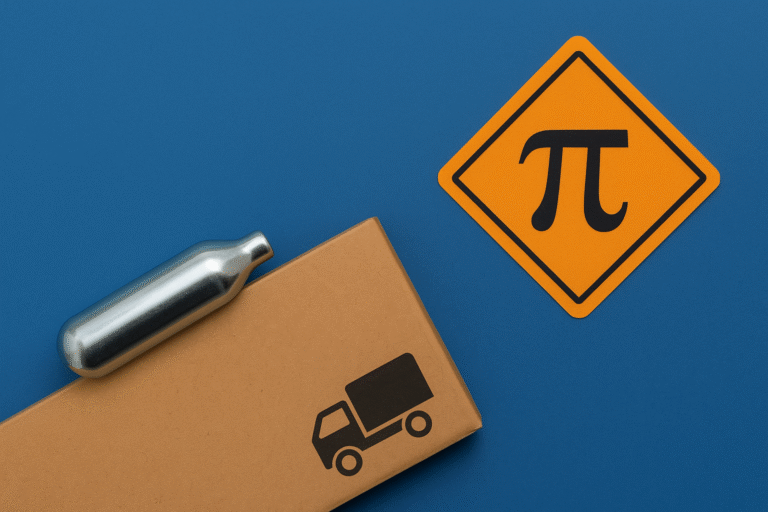You’ve confirmed your tank size, flavor, and certificate—but your shipment gets blocked at the EU port. Why? No TPED marking.
Many cream charger importers don’t realize that for tanks above 8g, especially 640g and 3.3L cylinders, TPED certification with π mark is mandatory for legal transportation inside the European Union.

As a manufacturer exporting across Germany, the Netherlands, and Spain, I’ve helped clients unlock shipments, pass customs checks, and avoid ADR violations by understanding this small—but powerful—π symbol.
1. What Is TPED Certification?
TPED stands for Transportable Pressure Equipment Directive (EU 2010/35/EU). It governs the legal safety standards for:
- Gas cylinders
- Valves
- Pressure accessories
If you want to ship N2O tanks across European borders—even after customs clearance—you must comply with TPED.
💡 Without TPED, your tanks may be:
- Denied transport by carriers (DHL, DB Schenker, etc.)
- Rejected by EU warehouses or supermarkets
- Flagged during roadside or port inspections
2. What Is the π (Pi) Mark and Where Should It Appear?
The π mark is a legal symbol of TPED compliance. It looks like this:
π 1234 (where 1234 is the Notified Body number that approved your tank)
This mark must be:
- Permanently engraved or printed on the tank body
- Linked to a real TPED certificate with traceable batch numbers
- Visible on outer packaging or shipping labels (if required by carrier)
📌 Fake or missing π marks = non-compliance under ADR transport rules.
3. Which Cream Charger Sizes Require TPED?
| Size | TPED Required? | Why |
| 8g | ❌ Optional | Small enough to be exempt from transport directive |
| 640g / 580g | ✅ Yes | Treated as pressurized cylinder |
| 3.3L / 2000g | ✅ Yes | High-pressure transport item |
| 1L tanks | ✅ Yes | Exceeds ADR limit for personal exemption |
💡 Tip: Even if your product is “food-grade” or CE certified, you still need TPED for EU-wide transport.
4. What Happens If You Skip TPED?
Without TPED:
- Your freight forwarder might refuse loading from factory
- Port authorities can seize or delay your cargo
- You may face fines or re-export charges
- Your brand risks being blacklisted by large distributors
📦 We’ve seen buyers lose €8,000+ in re-routing fees and storage penalties just for missing π mark on 640g tanks.
5. How to Verify Real TPED Certification
Many suppliers claim “TPED certified”—but how do you know it’s real?
✅ A legitimate TPED certificate includes:
- Notified Body number (e.g., NB 0035)
- Validity date
- Covered tank type (e.g., UN1070, N2O)
- Pressure specifications
- Matching π mark format
You can check the Notified Body via the EU NANDO Database to confirm it’s recognized.
🧠 Pro Tip: Request both the certificate PDF and tank photos with visible π marking.
6. What’s the Relationship Between TPED and CE?
Many confuse CE and TPED. Here’s the difference:
| Feature | CE | TPED |
| Covers product safety | ✅ | ❌ |
| Covers transport safety | ❌ | ✅ |
| Required for N2O in EU? | ✅ (for sales) | ✅ (for shipping) |
| Symbol | “CE XXXX” | “π XXXX” |
| Applies to 8g tanks? | Yes | No |
| Applies to 640g+? | Yes | Yes |
📌 You need both for full EU compliance. CE for sale. TPED for transport.
7. Who Needs TPED the Most?
| Buyer Type | Risk Without TPED | Recommendation |
| EU Distributor | 🚨 High | Must demand TPED from supplier |
| Freight Forwarder | 🚧 Medium | Needs TPED to handle cylinder declaration |
| OEM Brand | ❌ Critical | TPED required for private-label imports |
| End-user / Café | ✅ Low | Not required for on-site use |
| Africa/Asia Buyer | ❌ Often not needed | Can skip unless transiting via EU hub |
Conclusion
The π mark might look small—but it holds your shipment’s fate. If you’re importing cream chargers into Europe, TPED certification isn’t optional—it’s your legal ticket through the supply chain.
At nitronovae, all our 640g and 3.3L cylinders come TPED-compliant, batch-stamped, and certificate-matched. Want to receive real TPED samples or request our batch inspection video?




